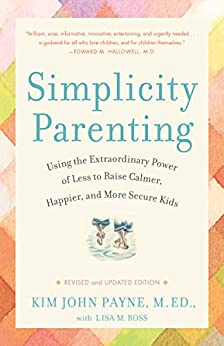More on this book
Community
Kindle Notes & Highlights
Read between
March 4 - March 15, 2019
four levels of simplification: the environment, rhythm, schedules, and filtering out the adult world.
The attribution of creativity has shifted away from children, who come by it quite naturally, to the efforts of executives in toy company boardrooms, who claim the power to “develop” and “stimulate” creativity. An overemphasis on toys co-opts and commercializes play, making it no longer a child’s natural world but rather one that’s dependent on adults, and the things they provide, to exist.
Our generous impulses can also go awry. After all, if toys are seen as universally beneficial, then we have an unlimited pass to buy, buy, buy, and buy one or two more. What started as a generous desire to please and provide can assume its own life. It can become addictive, feeding our own needs rather than our children’s.
there will be plenty of “multiples” in your child’s mix of toys. However, if one speedy race car is a delight, that does not mean that three of them will be delight cubed. If your child has many versions, or copies, of the same toy, consider reducing the number to a more manageable and lovable little group. This is especially important if the original toy (not the “clones”) is one your child has imbued with special affection and loyalty.
A deep comfort in one another’s company is what we look for in family; it’s what we want our children to feel. A sense of ease that doesn’t depend on a shared interest, activity, or conversation.
The pressure is off when childhood is no longer seen as an “enrichment opportunity” but instead as an unfolding experience—an ecology—with its own pace and natural systems.


